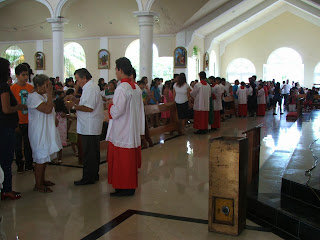 |
| Notice: only 2 Extraordinary Ministers for a huge parish |
The short answer is, in most small to medium parishes, none.
I've been to medium sized parishes in the Mexican countryside where those partaking would rather line up out of the door and have mass go overtime overlapping with the beginning of the next mass (creating the kind of disorganized chaos that is a part of normal life in Mexico anyway) than receive the Eucharist from anyone but the priest.
These same parishes also offer communion under both species by means of intinction (dipping the Body of Christ into the Precious Blood), making it impossible to rush through in any way because of the special care required (and probably offering yet another reason not to have anyone but the priest delivering.)
 |
| Even the elderly man using the walker prefers to approach the altar |
My wife and I are reminded of this every time we go back to Mexico. While in Playa del Carmen, there are Extraordinary Ministers, and they do not practice intinction, our home parish here (Our Lady of Guadalupe) demonstrates the point as well.
We estimate that an any given Sunday Mass there are probably between 1000 and 1500 people present (and there are 5 Sunday Masses.) And how many Extraordinary ministers are there?
2.
The priest is in the middle in front of the altar, and the other 2 (usually the leading nun, and a deacon) are at the front of the side aisles. No one goes to the back of the church. Everyone approaches the altar.
I have been to parishes in Canada that have less than 1/10 of that mass attendance. Yet they have 2 or 3 extraordinary ministers. One goes to the back of the (very small) church. I'm not sure why that is considered to be necessary.
 |
| The Precious Blood and Body of Christ |
Mexican Catholicism isn't by any means perfect. It has its flaws - some of them glaring. But there are certainly good points we could pick up from them.
No comments:
Post a Comment